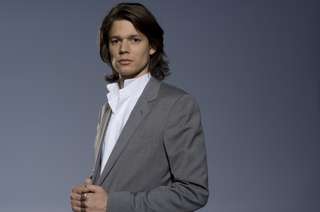|
Back
Sound Choices! New York
Avery Fisher Hall, Lincoln Center
12/03/2009 - & Dec. 4, 5, 8*
Béla Bartók: Music for Strings, Percussion and Celesta
Maurice Ravel: Piano Concerto in G
Claude Debussy: La Mer
David Fray (Piano)
New York Philharmonic Orchestra, Esa-Pekka Salonen (Conductor)

D. Fray (© Sumyo Ida/Virgin Classics)
When Esa-Pekka Salonen joined the Los Angeles Philharmonic in 1992, he became the first Finnish artist since Jan Sibelius to become a household name. While he inevitably opened the portals to a whole herd of Finn musicians stampede into America like over-achieving Lapp reindeer, Esa-Pekka Salonen is still the name to be reckoned with, as composer and conductor.
His too rare visits here should soon increase, having relinquished his treasured West Coast post. For his performance these last four days with the New York Philharmonic he showed a fine musician at work, without exaggeration or idiosyncrasy, with a very willing orchestra.
The three works were well-chosen. All were 20th Century, but none needed a set of rules for understanding. Each were easily accessible, yet they gave the orchestra a physical workout. And while two of the three were so carefully composed that the conductor almost has his work cut out for him, Mr. Salonen gave them a singular musical personality.
That personality had a challenge in the Ravel G Major Concerto. The composer insisted his music “is set down in definitive form.” But the young French pianist, David Fray, with his Renaissance-style long hair and deft fingering, gave a “definitive” performance. At the same time, it was certainly a classical one. That first snap of the orchestra led to playing which was perfectly balanced, digitally deft. The second movement was not highly emotional, but the melody sung like an aria. Finally, the dazzling octaves in the last movement showed how he can handle anything.
The conductor made some surprising choices. (The horns in the first movement overwhelmed the soloist), but his beat was right for such a careful pianist.
The opening Music for Strings, Percussion and Celesta was another example of music written so tightly, with such rigidity that no conductor wold dare depart from the score. Recordings, though, cannot do justice to the meticulous instructions about seating the orchestra, the result being one of the first examples of “spatial” music. The accumulative theme coiled around and around itself, each measure intense to the point of bursting. The rareness of the performance was how carefully Bartók had made the sounds on each side of Avery Fisher’s stage spark each other off. I was tempted to call it antiphonal, but this was not simply resonant. It was a spectrum of music in time and space coiling with as much interest as that opening fugue.
A carefully-miked recording does have the advantage of giving clarity to the strings, but live, the blurs were inevitable. Yet Mr. Salonen, a master of control, did allow that crescendo to rise and fall oh so precisely. The final movements were clearer in texture, and the Bartók became a study in sonorities.
As would be expected, La Mer was a more personal treat for Mr. Salonen and the orchestra together. Having recently been to the Eastbourne seashore, where the composer wrote La Mer, I must say that the Salonen image of the sea was more arousing, certainly more interesting than the actual waters themselves.
Harry Rolnick
|